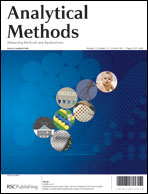Experimental design of directly suspended droplet liquid–liquid–liquid microextraction has been used to determine residue of 2,4-D, in environmental water samples. A free suspended droplet of 5.5 μL of receiving phase is delivered to the top-center position of 1-Octanol, which is an immiscible organic solvent, floating on the top of a 2.5 mL aqueous sample while being agitated by a stirring bar to create a mild vortex at the center of the vial. Central composite rotatable design has been used for studying the effect of the parameters, the factors interacting with each other and finding the optimum condition. The chromatographic separation was accomplished on a shim-Pak C18 column using a mixture of 10 mmol L−1 NaH2PO4 (pH = 5.4) : acetonitrile (40 : 60, v/v) as mobile phase at a flow rate 1 mL min−1 with UV detection at λ = 220 nm. In order to achieve the maximum extraction efficiency, different parameters affecting the extraction were optimized. Under the optimized conditions, preconcentration factor of 130 and limit of detection (LOD) of 0.3 μg L−1 were obtained. The calibration graph was linear within the range of 0.8–1500 μg L−1. Finally, the feasibility of the proposed method was successfully confirmed by extraction and determination of 2,4-D in real water samples in the range of microgram per liter and suitable results were obtained (RSDs < 6.4%).

You have access to this article
 Please wait while we load your content...
Something went wrong. Try again?
Please wait while we load your content...
Something went wrong. Try again?


 Please wait while we load your content...
Please wait while we load your content...